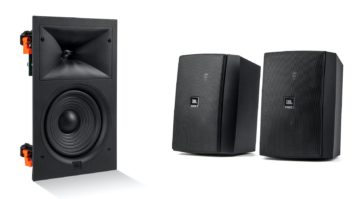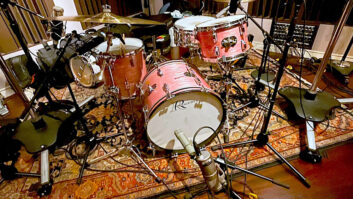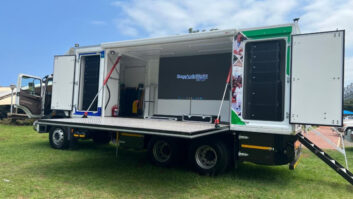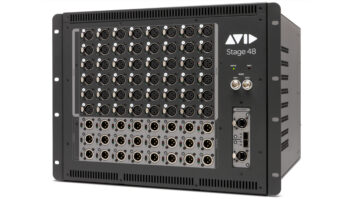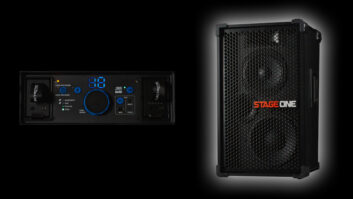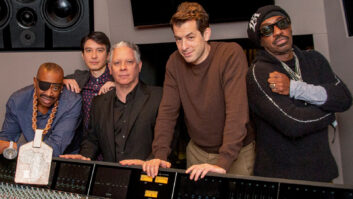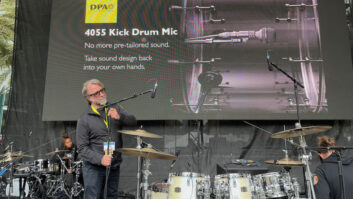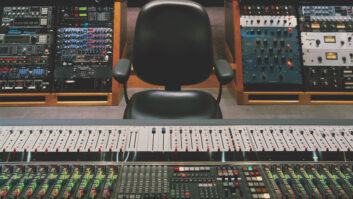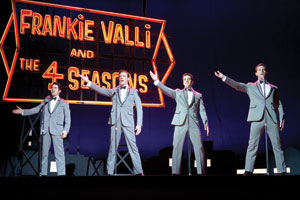
L to R: John Lloyd Young as Frankie Valli, Erich Bergen as Bob Gaudio, Vincent Piazza as Tommy DeVito and Michael Lomenda as Nick Massi in Warner Bros. Pictures’ musical Jersey Boys.
Photo: Keith Bernstein © 2014 Warner Bros. Entertainment Inc. and RatPac Entertainment
Has the live singing in the hit film adaptation of Les Miserables changed the game for everyone else making an on-screen musical? Is the era of lip-synching to pre-recorded tracks over forever? Probably not. But for the greatly anticipated film of the Broadway (and touring) smash Jersey Boys, director Clint Eastwood and his sound and music teams have upped the ante even more: In addition to having mainly live vocals throughout, most of the music we hear was also performed live at the same time. (By contrast, Les Miz’s actors sang to a live piano track in their earpieces, with orchestrations done after the fact. On Jersey Boys, there were some vocal and instrumental sweetening sessions later, for reasons we’ll explain.) But enough with the comparisons, as the two projects could not be more different in every other way.
Jersey Boys, of course, tells the story of Frankie Valli and his group the Four Seasons—their rise in the ’50s and early ’60s, their personal and professional triumphs and struggles in and outside the record biz, Valli’s solo career and, ultimately, the amazing durability of their impressive catalog of songs, which includes “Sherry,” “Big Girls Don’t Cry,” “Walk Like a Man,” “Rag Doll,” “Let’s Hang On” and so many others. The stage show of Jersey Boys features a relatively simple (but creatively employed) stylized set, but Eastwood decided to go a different route with his film—total realism and period-accurate details from top to bottom, covering from the ’50s to the ’90s (when the Four Seasons were inducted into the Rock & Roll Hall of Fame), including all the cars, appliances, musical instruments, microphones and recording equipment depicted.
This was not a surprise to the sound team, who have been working with Eastwood forever, it seems. Supervising sound editors Alan Murray and Bub Asman and re-recording mixers Gregg Rudloff and John Reitz all go back more than 30 years with the director, and most of the others have toiled on multiple Eastwood films, so they know what he wants and expects from period films. They also know that he will give them tremendous latitude to develop the soundtrack based on their experience and their instincts. Still, it has to be right.
“We really had a lot of fun with the cars on this one,” Murray says. “They were driving around in these huge ’61 Caddies. Usually they go to collectors and rent them, but Clint, who’s a big car guy, actually bought a bunch of the cars before production started. They were all original, with the big exhausts on the Caddies. The latest car [he bought] was a ’62 Caddy, and then we had a ’53 Olds, a Packard sedan and a Studebaker. One thing that was great is, because they shot a lot of the sequences in Jersey Boys here on the [Warner Bros.] backlot, we actually had the cars used in production, and we went to the exact location where they shot the scene, so everything matched perfectly. It was a total blend between production [recordings] and what we do afterwards, which is go out and re-record all the cars. It was great to be able to go on the actual corner where the guy was turning, and to record the sound in those perspectives.” Murray and noted effects recordist John Fasal did most of the car recordings, including some interiors captured with a DPA 5100 surround microphone. Fasal usually records effects with a Sound Devices 788; Murray with a Fostex FR-2.
“Clint would recognize if I wasn’t using the right cars—that’s important to him,” Murray says. “I got that a few times when I used something on a background car that wasn’t ‘correct.’”
Still, effects re-recording mixer Rudloff says, “There’s always a balance between reality and what you’re trying to accomplish with the telling of the story. For us, as far as levels go on a car engine or a rotary phone or whatever, it’s about how it fits the moment of the storytelling. So I’m never really concerned about whether it’s the ‘right’ level in terms of how loud a phone would have been in 1962. It’s about having the proper sounds and then making them fit the moment and the emotion of the scene.”
Of course, it’s the music that really carries the film—as it does the stage show—and there are many different locales where songs pop up. Rudloff notes, “There’s everything from a cappella on the street, to inside recording studios, to small clubs, to larger nightclubs, to The Ed Sullivan Show, American Bandstand; they cover the gamut of locations, and part of the challenge was to keep the sound of the songs, but have them fit those venues.

John Reitz, Alan Murray (center) and Gregg Rudloff
Photo: Bob Beresh
“What the guys on the music side did is they went out and got IR [impulse response] recordings of the venues, then came in and worked at replicating that, so we had a basis to start with that fit those venues,” he continues. “But then it becomes all about the perspective of the shot and the camera angle, so it was a combination. John [Reitz] would also add in and tweak various locations. Where John really had his work cut out for him as far as matching was on the P.A. stuff, when they would be speaking dialog into the microphone. He put a lot of effort into that because the music guys weren’t working with that in mind.”
Rudloff also notes that it was not easy “to match period and still give the audience the full flavor of the music, no matter what the location. People have been hearing this music for decades, so everybody has got this impression in their mind of what it sounds like, and we didn’t want to stray too far from that. For us, it was about the power of the music, the emotion of the music, re-creating that from the original time, rather than in today’s world, where we could use this piece of gear and do this, and it might sound different or better.”
The decision to record the singers and musicians live during filming was made to give the film some of the raw immediacy of the stage show. It helped that three of the four singers in the group had played their roles onstage in Jersey Boys. “They were the most professional and happy group of people you could ask for,” Murray says. “They would go in and do the re-records and, singing these songs so many times in the Broadway musical, they really had them down. The re-records were done at a place in Glendale called The Bridge Recording.”
Why do re-records at all? Mostly to have more control over the individual performances of the four singers. Rudloff says, “There are moments in the film where guys would huddle around the mic, two or more singing into a single mic at the same time. But they did individually mike the actors, because they wanted as much separation as possible. And that’s another reason the re-records took place—for that additional separation. For dramatic purposes at various times, you wanted to feature one vocal over another, or one instrument over another, and that’s where the re-records came in handy, because we had better isolation with those.” Walt Martin, who was the production sound mixer, recorded both the dialog and the singing on-set.
Recording the music live presented its own set of unique problems. During most of the film, when we see musicians backing the Four Seasons onstage, most of those players are miming their parts for the cameras, while studio musicians offstage are actually playing to the live vocals of the group (or singer). The exception, in a number of scenes, was drums: “About 80 percent of the time, the drummer onstage was real, and a lot of the time it was Bernie Dresel, a fantastic drummer who has played with Brian Setzer and has a great look,” says Tim Boot, who was the production music mixer on the film. “Originally, he was only going to play a couple of days, because back then they didn’t keep the same drummer. And there were some scenes where it was a different drummer, so we took Bernie and put him off-camera, and we’d build an iso booth out of packing blankets to surround the drums to get a decent recording.” The singers would hear the music through low-volume monitor wedges, and occasionally employed discreet earwigs for pitch purposes.
Since Dresel was on-camera in so many scenes, Boot had to devise a way to mike the drums unobtrusively, because, he says, “in the ’50s and ’60s, drums weren’t miked [in live performances]—in fact usually the only mics onstage were for vocalists. So how do you do a modern recording when you can’t even have prop mics? I worked with DPA, and we got a package of compact mics and close-miked the drum kit, concealed, so when you see a drum on camera, every element of the kit is individually tracked, modern-recording style, but you can’t see it.”
The mics of choice there were DPA d:vote 4099 clip-ons and d:screet 4061 omni miniatures. Another scene has a full big band playing in the ’70s, “with five reeds, four trumpets, four ’bones, piano, bass, drums, and that was all multitracked live, too. In that era, there would not have been a microphone on every instrument like we would do today, so we got a ton of compact mics, and every single instrument was close-miked discreetly—a lot of DPAs, and we also had some others—[adding up to] 48 inputs.
“Most of the [music] scenes are live sound—not recording studios,” Boot continues, “and most live sound microphones were terrible-sounding up until the 1980s. Recording studios had great microphones in the ’50s and ’60s—all those old RCAs and Neumanns and Telefunkens; stunning, but studio mics. So to be accurate they couldn’t use those in a live situation. The one flaw in the system was that the prop department would show up with these mics that looked great but unfortunately sounded like garbage, so in some cases Walt [Martin] actually taped a DPA lavalier on the front of the capsules of these bad mics. At least in the recording studio scenes we could have U47s and C12s.” The guitarist, bassist and keyboardist who played unseen offstage were captured with DIs.
“The intent was,” Boot says, “that I would record the music, Walt would record the vocals, and then we would fold down mixes to Mark Agostino, so toward the end of the day, when the singers were tired, or they were filming not on the singers, we would go back and use traditional playback on what we had recorded live. So Mark was taking those and playing them back.” Boot had a PreSonus StudioLive 16.4.2 mixer at his position right near the offstage band, “and I also brought a collection of Millennia and Grace mic pre’s. So I was multitracking into Pro Tools, and at the same time I was mixing down to stems—mono drums, guitar, bass, keyboards—mixing that and sending that to Mark, because he didn’t need the big spread that I had.”

Tim Boot
Rudloff says the musical director of the stage show, Ron Melrose, was on hand at The Bridge for the re-records, “and we also had huge support from the music editors—Chris McGeary and Tommy Lockett—and Bobby Fernandez did all of the re-records and then the mixdowns. He’s worked with Clint and with us for many, many years; he’s part of the family.
“In the end, there are songs that are completely live production, and there are songs where it’s a hybrid of production and re-records for this portion or that portion.” The music arrived to Reitz with those decisions about what to use in the mix already made by Fernandez, “but John always had the separation—the material to make adjustments,” Rudloff says. “Which I did make,” Reitz adds.
The final mix took place on dubbing Stage 9 at Warner Bros.—an AMS Neve DFC Gemini room—with neighboring Stage 10 being utilized for the film’s Atmos mix. “I view Atmos as another creative opportunity,” Rudloff comments. “It’s another chance to use the spatial environment to help tell your story. The way Clint tells his story, we weren’t looking to go crazy with Atmos. This isn’t something where we’re going to take something and zing it around the room just because the capability is there. The whole purpose is to enhance but not distract. With Atmos, you can actually add a level of clarity because you’ve got a better opportunity for separation. And that’s as wonderful in a movie like this as it is in an action film.”
